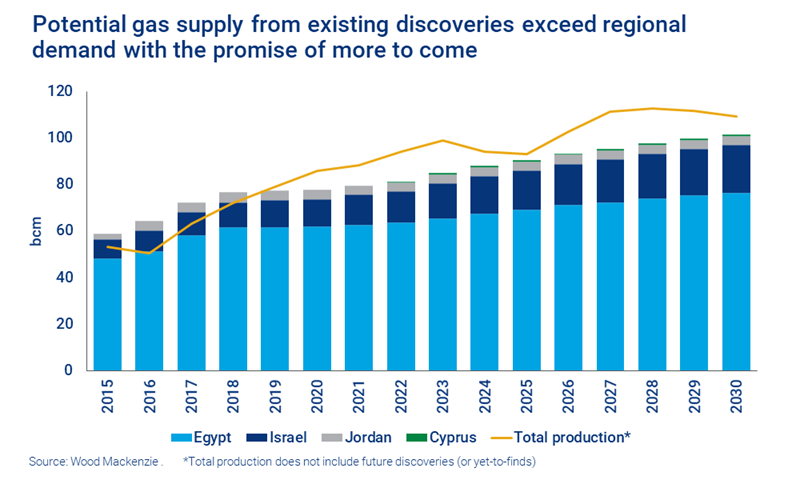Monetising the East Med’s giant gas finds
Could an LNG hub break down the geopolitical barriers?
1 minute read
Simon Flowers
Chairman, Chief Analyst and author of The Edge

Simon Flowers
Chairman, Chief Analyst and author of The Edge
Simon is our Chief Analyst; he provides thought leadership on the trends and innovations shaping the energy industry.
View Simon Flowers's full profileThe East Mediterranean has the potential to be a gas province of global significance and drive prosperity for the region’s economies in the coming decades. Big Oil has already moved in, recognising the long-life growth opportunity. The path to full commercialisation, though, won’t be straightforward. Jean-Baptiste Bouzard, Upstream, and Nnenna Amobi, Gas and LNG, identify three elements to how it might play out.
First, there’s exceptional resource potential in the region. It’s a petroleum geologist’s fantasy. The thick sedimentary columns are rich in biogenic gas, different to the thermogenic gas plays the industry has exploited for a century or more. Biogenic gas is diffuse through the rocks; the trick is finding a reservoir where the gas is concentrated in commercial volumes. In the East Mediterranean, that’s beneath the seal – a thick layer of salt, formed when the entire Mediterranean evaporated five million years ago.
Geologists found the key to unlock giant fields only in the last decade or so. The biggest are Tamar (discovered in 2009) and Leviathan (2010) in Israel; Zohr (2015) in Egypt; Aphrodite (2012), Calypso (2018) and Glaucus (2019) in Cyprus. Collectively, these hold almost 70 tcf of gas. There’s perhaps the same again in yet-to-find resources, including Lebanon, making it one of the top three prospective gas basins in the world.
Second, the opportunity to commercialise discoveries has made the region a magnet for Big Oil. Most of the Majors are there – Eni, which discovered Zohr and Calypso, ExxonMobil (Glaucus), BP (a long-time player in Egypt), Total and Shell; while Chevron was the big winner in Egypt’s latest licence awards this year. Independents, including Delek and Noble Energy, were the architects in Israel where Energean is also active. Rosneft and Qatar Petroleum have also taken positions in the region.
Egypt and Israel both have sizeable domestic markets which have supported the development of offshore discoveries. But the scale of the regional resource dwarfs local needs. The build-up of production from Leviathan, onstream in late 2019, enabled Israel to start pipeline exports to Egypt this year. For its part, Egypt was able to cease LNG imports and ramp up LNG exports last year.
Third, there’s geopolitics and security of supply concerns, which threaten to stall or even block full-scale commercialisation of the region’s resource. Turkey’s relations with Cyprus remain a potential flashpoint. It’s natural that Egypt, Israel and Cyprus will want to secure future gas supply for their domestic market. But there also needs to be recognition that there’s ample gas to support exports. The question is how to make the most of the opportunity?
An export pipeline to Europe has been mooted. The logistics – from physical assets to the need to cross multiple borders – mean a multibillion-dollar price tag. Europe wants to diversify its supply, but not at any cost. There’s also rising market risk for investors given the uncertainty around gas demand from the EU’s plan to be net-carbon neutral by 2050.
LNG is the obvious alternative, and a more flexible option. An LNG hub based around Egypt’s existing ELNG and SEGAS LNG terminals can enable the East Med to tap into global gas markets. It could also be very competitive on costs. The biggest upstream projects which have economies of scale could deliver feed gas for under US$2/Mcf on our estimates. Cash costs in total would be around US$3.50/Mcf FOB after tolling fees.
That would rank East Med LNG cheaper than Novatek’s Arctic LNG and the best US LNG projects. Investment in the upstream, mid-stream and downstream phases of the project would bring economic stimulus to Israel, Cyprus and Egypt, not to mention future tax revenues. Export revenues would boost each country’s balance of payments.
The obstacles to a regional LNG hub, though, are daunting. Can Egypt countenance buying feed gas for LNG at prices lower than the US$4/Mcf-plus it currently pays for gas to sell into its domestic market? Can the multiple upstream operators with differing ambitions and timescales find a way to coalesce around common export solutions? Can deep-rooted regional tensions be put aside to make a hub happen?
A balanced solution that works for all interested parties – governments, nations, oil and gas investors – holds the promise of a new economic engine for the region. Joint development might even help defuse regional tensions. But progress and success will need compromise, cooperation and partnership. Without those, a lot of gas will stay in the ground, undeveloped and stranded.
More insight into the issues shaping your industry
Every week in The Edge, Simon Flowers shares his take on the natural resources industry's biggest stories, how they are likely to evolve and what that means for your business. Fill in the form at the top of this page to receive The Edge in your inbox.







